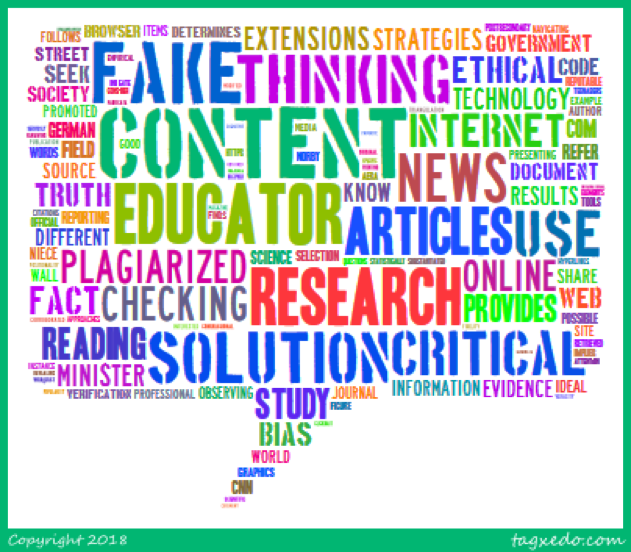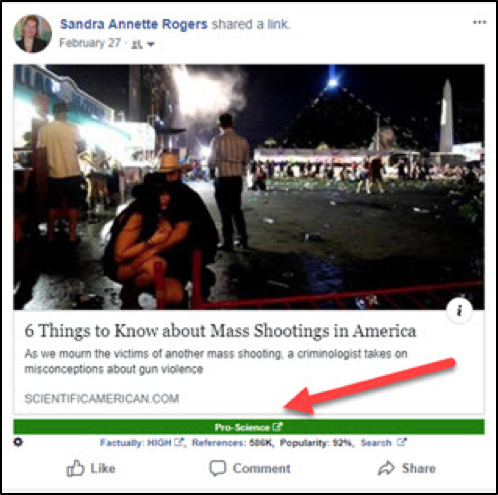Navigating Post-Truth Societies: Strategies, Resources and Technologies

This post is the second in a series in which AACE social media interns follow up on the latest Innovating Pedagogy Trend Report 2017 – read the review and summary by Allie Aylan. As Ferguson et al. (2017) stated: “This year’s innovative pedagogies include some that have an urgency about them. They are addressing problems of today’s world, where learners are faced with fake news, pseudo-science, ‘post truth’ and increasing tensions between some communities”. Rima Chamout tackled the topic Intergroup Empathy, and Sandra Rogers current contribution discusses ways to help students navigate post-truth societies.
“Fake news” has become a politicized and controversial term, used both to criticize mainstream media and to refer to problematic content online (Caplan, Henson & Donavan, 2018). Consequently, the Innovating Pedagogy report sees fostering ‘epistemic cognition’ as a high impact trend that will influence higher education over the next 2-5 years. Sandra Rogers illustrates the problem and discusses four possible solutions in pursuit of truthful online content.
The Problem
While fake news and information bubbles are not new, awareness of their impact on public opinion has increased. The Wall Street Journal (2016) reported on a study that found secondary and postsecondary students could not distinguish between real and sponsored content in Internet searches. This became apparent to me when observing my college-bound niece google her bank on the Internet and quickly click the name at the top of list within the sponsored content and then have the computer freeze from a potential malware attack. If teenagers cannot discern between promoted and regular content, imagine their encounters with fake news. The WSJ article recommended lateral reading (i.e., leave site to learn about it) and for adults to ask teens about their selection choices during Internet searches. In the instance with my niece, she was unaware of sponsored content. She also didn’t know that the first item in a browser’s search results generally is strategically pushed to the top because of search engine optimization (SEO) with key words (meta tagging).
 .
.
Figure 1. Tag cloud of words from blog post
How can we help? What are good heuristics to determine the quality of online content?
Solution 1. Critical Reading and Thinking Skills
Determine the purpose of the Website by its domain (e.g., .com, .org, .gov). Analyze its content and graphics. Analytical questions to consider are as follows:
- Is it current? Broken hyperlinks indicate a lack of attention to the site.
- Does it look professional? Is it well written?
- Does it have a point of contact?
- Does the writer provide proper citations?
- What is the author’s tone? Is the content biased toward a view? If so, is it substantiated with empirical evidence? Does the author present the complete narrative or are certain important elements omitted?
- Do the graphics illustrate a valid point? Do they make sense statistically?
Are you IT specialist, researcher, or educator? Each field has different approaches to thinking. The strategies you select would depend upon the nature of the content, as different content requires different ways of thinking. Bruning, Schraw, and Norby (2011) refer to this as thinking frames such as how one would think about scientific inquiry and the use of research methods. If you’re an educator, you might be interested in a WebQuest I developed to help students create their own job aid for critical thinking. It asks students to tap into the critical lens of their future field of study.
Solution 2. Primary Sources
Combat fake news by seeking the original source of information. Take time to verify the authenticity of what is begin shared online. Use various sources whenever possible for triangulation (e.g., interviews, observations, and documentation). This will ensure that what you read is corroborated by other articles presenting the same information. A good legislative resource is the U.S. Government Publication Office that provides congressional records, bills, codes, and Federal Register items. Their govinfo.gov website explains how to check the integrity of a government document found on the web by revealing its verification seal upon printing. It’s a digital signature placed in their PDFs; if the document has been modified, it breaks the verification.
Solution 3. Technology Resources
Use technology to decipher the trustworthiness of online content. Several Internet browser extensions provide visible alerts. For example, the Fake News Detector extension displays the word FAKE in red capital letters or orange for CLICKBAIT/Probably FAKE on the web page. It is available in the Chrome store along with a few others and their user ratings. I started curating reputable fact-checking tools such as PolitiFact and Snopes on my Scoop.it! e-magazine, The Critical Reader. Some extensions are application specific such as the Official Media Bias/Fact Check Extension that determines the veracity of articles on Facebook. It provides factuality (e.g., High), references, popularity, and positionality (e.g., left-center) at the base of the article on your FB feed. I personally use this one displayed in Figure 2.

Figure 2. Facebook post of Smithsonian article with Official Media Bias/Fact Check results
Solution 4. Seek Professional Content
Seek information from reputable researchers and educational leaders. Most professions adhere to ethical standards as a promise to their constituents. For example, the American Educational Research Association (AERA) states that members will not fabricate, falsify, nor plagiarize “in proposing, performing, or reviewing research, or in reporting research results (AERA Code of Ethics, 2011).” This standard is taken very seriously in the field of educational research. Those in the past that did not heed ethical rules have paid the cost of being outed with plagiarism tools such as was the case for the German Education Minister and Former Defense Minister’s plagiarized dissertations and subsequent unseating of their government appointments (CNN World, 2013).
As an educator, I took the Kappa Delta Pi (KDP) pledge of fidelity to humanity, science, service, and toil, as an initiate into this international honor society. The ideal of science relates to the topic of this discussion, “…This Ideal implies that, as an educator, one will be faithful to the cause of free inquiry and will strive to eliminate prejudice and superstition by withholding judgment until accurate and adequate evidence is obtained. One will not distort evidence to support a favorite theory; not be blinded by the new or spectacular; nor condemn the old simply because it is old. All this is implied in the Ideal of Science (KDP Initiation Ceremony, 2015).”
Do you have good fact-checking resources or more solutions to share? Please share those in the comments section.
References
Brumfield, B. (2013, February 6). German education minister loses Ph.D. over plagiarized thesis. CNN World. Retrieved from https://www.cnn.com/2013/02/06/world/europe/german-minister-plagiarism/index.html
Bruning, R. H., Schraw, G. J., & Norby, M. M. (2011). Cognitive psychology and instruction. New York, NY: Pearson.
Caplan, R., Hanson, L. & Donovan, J. (2018). Dead Reckoning Navigating Content Moderation After “Fake News”. Data & Society. Retrieved from https://datasociety.net/pubs/oh/DataAndSociety_Dead_Reckoning_2018.pdf
Code of ethics. (2011). American Educational Research Association. Educational Researchers, 40 (3), 145-156. doi: 10.31.02/001189X11410403
Ceremonies and rituals. (2015). Kappa Delta Pi International Honor Society in Education.
Shellenbarger, S. (2016, November 21). Most students don’t know when news is fake, Stanford study finds. The Wall Street Journal. Retrieved from https://www.wsj.com/articles/most-students-dont-know
